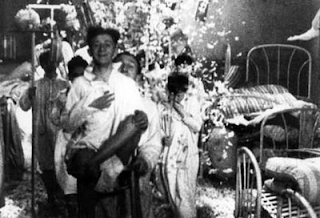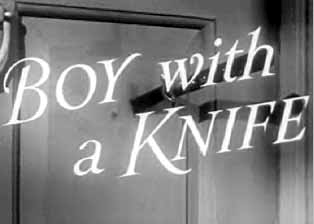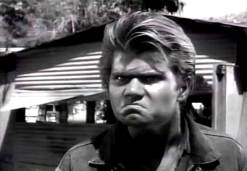 Oddball Films presents Bad Behavior, a program exploring teen traumas, cultural conflict and youthful rebellion. Whether in a French Boarding school in 1933 or on the streets of the San Francisco’s Mission district in 1971 disaffected youth have many ways to express their frustration. The program features the legendary Jean Vigo film Zero for Conduct (1933). One of the most poetic films ever made and one of the most influential, Vigo based his first fictional film on his own miserable experiences in a French boarding school, and the result is one of the greatest films about youth ever made. Its influence is felt in other filmic tales of disaffected youth, from Francois Truffaut’s The 400 Blows(1959) to Alan Parker’s Pink Floyd: The Wall(1982), and Lindsay Anderson’s If… (1968). Also screening will be the noirish story of a tough teenage boy Boy With a Knife (1956) starring B-movie legend Richard Widmark and Chuck Connors and The Bully (1951), a classic mental hygiene film featuring Chick Allen-school bully! Plus! Clips from the rare, shot-in San Francisco film Latino: A Cultural Conflict (1971) charting the path of a Salvadorian delinquent in SF’s Mission district. With priceless shots of the Mission.
Oddball Films presents Bad Behavior, a program exploring teen traumas, cultural conflict and youthful rebellion. Whether in a French Boarding school in 1933 or on the streets of the San Francisco’s Mission district in 1971 disaffected youth have many ways to express their frustration. The program features the legendary Jean Vigo film Zero for Conduct (1933). One of the most poetic films ever made and one of the most influential, Vigo based his first fictional film on his own miserable experiences in a French boarding school, and the result is one of the greatest films about youth ever made. Its influence is felt in other filmic tales of disaffected youth, from Francois Truffaut’s The 400 Blows(1959) to Alan Parker’s Pink Floyd: The Wall(1982), and Lindsay Anderson’s If… (1968). Also screening will be the noirish story of a tough teenage boy Boy With a Knife (1956) starring B-movie legend Richard Widmark and Chuck Connors and The Bully (1951), a classic mental hygiene film featuring Chick Allen-school bully! Plus! Clips from the rare, shot-in San Francisco film Latino: A Cultural Conflict (1971) charting the path of a Salvadorian delinquent in SF’s Mission district. With priceless shots of the Mission.
Venue: Oddball Films, 275 Capp Street, San Francisco
Date: Thursday, June 7, 2012 at 8:00PM
Admission: $10.00 Limited Seating RSVP to programming@oddballfilm.com or 415.558.8117.
Featuring:
Zero For Conduct (Jean Vigo, 1933, B&W)
“One of the most poetic films ever made and one of the most influential.” – New Yorker
Jean Vigo based his first fictional film on his own miserable experiences in a French boarding school, and the result is one of the greatest films about children ever made. It’s influence is felt in other filmic tales of disaffected youth, from Francois Truffaut’s The 400 Blows (1959) to Alan Parker’s Pink Floyd: The Wall (1982), and especially Lindsay Anderson’s If… (1968).
Zero was made for a mere 200,000 francs and shot by Vigo's friend Boris Kaufman, younger brother of Soviet "Kino-Eye" pioneer Dziga Vertov (A Man with a Movie Camera). It received a mixed reception on its initial 1933 release and was soon banned for fear it would instigate civil unrest. Re-released in 1945, it has since been accepted as a landmark of world cinema. After completing L’Atalante in 1934, Vigo’s promising career was cut short by his death from septicemia at the age of 29.
The plot follows the misadventures of a group of young students as they endure the absurdities and deprivations forced upon them by their petty, authoritarian teachers. Matters escalate into a full-scale dormitory rebellion. Beds are overturned and pillows ripped open, resulting in a rain of feathers--one of the most beautiful images in this, or any, film. Finally, locked in an attic, the young rebels escape onto the roof and rain down a barrage of books, stones, and shoes onto a group of visiting dignitaries, inspiring the rest of the boys to revolt and take over the school.
Boy With a Knife (1951, B&W)
A rare film noir-like RKO social guidance film. Jerry, an "at-risk" young man, uses his knife as an "equalizer" to solve his frustrations stemming from his unhappy home, which is dominated by his stepmother. A group worker reaches Jerry and helps him to transcend his anger. Director: Laslo Benedek. Narrator: Richard Widmark. With Chuck Connors. A classic social guidance film!
The Bully (1951, B&W)
Social misfit and malcontent Chick Allen, the school bully, holds an unquenchable grudge against all that is good - and smaller - the kids in his class. Chick is constantly grabbing people by the shirt and throwing them to the ground. He wants to mess up the class picnic, but his plans are leaked by Skipper, one of his small lackeys. The class decides to thwart Chick and, at the same time, offer him a last chance to bond with society.
Plus!
Latino: A Cultural Conflict (1971, B+W)
Clips from a rare documentary shot by Brian Lewis on the streets of San Francisco's Mission District over 40 years ago. The film charts the alienation of teenager Mauricio from the Anglo community and his descent into drug use and criminal activity due to the cultural conflict between home versus school, and the unrealistic expectations of educators who expect Chicano students to conform to Anglo ways. Sound familiar?
 Oddball Films presents Bad Behavior, a program exploring teen traumas, cultural conflict and youthful rebellion. Whether in a French Boarding school in 1933 or on the streets of the San Francisco’s Mission district in 1971 disaffected youth have many ways to express their frustration. The program features the legendary Jean Vigo film Zero for Conduct (1933). One of the most poetic films ever made and one of the most influential, Vigo based his first fictional film on his own miserable experiences in a French boarding school, and the result is one of the greatest films about youth ever made. Its influence is felt in other filmic tales of disaffected youth, from Francois Truffaut’s The 400 Blows(1959) to Alan Parker’s Pink Floyd: The Wall(1982), and Lindsay Anderson’s If… (1968). Also screening will be the noirish story of a tough teenage boy Boy With a Knife (1956) starring B-movie legend Richard Widmark and Chuck Connors and The Bully (1951), a classic mental hygiene film featuring Chick Allen-school bully! Plus! Clips from the rare, shot-in San Francisco film Latino: A Cultural Conflict (1971) charting the path of a Salvadorian delinquent in SF’s Mission district. With priceless shots of the Mission.
Oddball Films presents Bad Behavior, a program exploring teen traumas, cultural conflict and youthful rebellion. Whether in a French Boarding school in 1933 or on the streets of the San Francisco’s Mission district in 1971 disaffected youth have many ways to express their frustration. The program features the legendary Jean Vigo film Zero for Conduct (1933). One of the most poetic films ever made and one of the most influential, Vigo based his first fictional film on his own miserable experiences in a French boarding school, and the result is one of the greatest films about youth ever made. Its influence is felt in other filmic tales of disaffected youth, from Francois Truffaut’s The 400 Blows(1959) to Alan Parker’s Pink Floyd: The Wall(1982), and Lindsay Anderson’s If… (1968). Also screening will be the noirish story of a tough teenage boy Boy With a Knife (1956) starring B-movie legend Richard Widmark and Chuck Connors and The Bully (1951), a classic mental hygiene film featuring Chick Allen-school bully! Plus! Clips from the rare, shot-in San Francisco film Latino: A Cultural Conflict (1971) charting the path of a Salvadorian delinquent in SF’s Mission district. With priceless shots of the Mission. 




